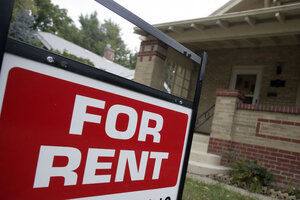Rent is less affordable than ever, and it’s not just a Millennial problem
The number of rent-burdened households, or those spending more than half of their income on rent, is expected to swell over the next decade, according to a new study. Elderly renters will be impacted most.

A 'for rent' sign is posted outside a home in Denver.
David Zalubowski/AP/File
Paying rent has become an enormous financial burden in recent years. On average, a record-high 30.2 percent of a US renter’s income goes toward housing, and it’s much higher than that in densely populated urban areas. And if prognosticators are right, it’s only going to get worse.
The number of “severely” cost-burdened rental households, or those spending at least half of their income on housing, is expected to balloon over the next decade, according to a joint study released by Harvard University’s Joint Center for Housing Studies (JCHS) and Enterprise Community Partners, Inc., a nonprofit advocacy group. The study’s authors estimate that such households will increase at least 11 percent to 13.1 million by 2025, possibly more if rental price growth continues to outpace income growth.
Thanks to how the makeup of the US population is changing, Hispanic, elderly, and single-person households will be affected the most. Older renters will be hit particularly hard. Those aged 65 to 74 will increase an estimated 42.1 percent, while renters 75 and older will see an estimated 38.4 percent increase.
“The findings suggest that even if trends in incomes and rents turn more favorable, a variety of demographic forces—including the rapid growth of minority and senior populations—will exert continued upward pressure on the number of severely cost-burdened renters,” the study reads.
About one in four renting households, or 11.3 million, were considered severely rent-burdened in 2013, according to the study. Just under half qualified as “moderately” rent-burdened, paying between 30 and 50 percent.
That growing burden is a lingering affect of the mid-aughts housing crisis. When the bubble burst, many homeowners were forced to become renters. That, combined with factors like increased household formation and young adults renting for an increased number of years, nudged the homeownership rate down to its lowest level since 1967, according to July data from the US Census.
As a result, there are a lot more people renting than in previous generations, and not enough affordable housing for all of them. Apartment occupancy rates in the US hit an all-time high 95.3 percent in May according to real estate analytics firm Axiometrics, and that tight market is driving up prices. The joint study reports that the last time it was tracked, 11.2 million extremely low-income households competed for 7.3 million homes affordable to them – a shortfall of 3.9 million homes.
At the same time, home price growth has continued to outpace wages, meaning even renters who want to buy have a tough road.
The findings follow a slew of other data suggesting that affordability of the nation’s rental housings is a slow-burning crisis. According to a Zillow report from August, renters can now expect to pay 30.2 percent of their incomes for housing, on average. In major cities it’s even more: In Los Angeles, for example, renters pay 50 percent, meaning a severe rent burden is the rule rather than the exception.
The solution, advocates say, will have to come from a combination of public action and private investment. Perhaps sensing an opportunity, builders stepped up construction of multi-family units in August, according to the Commerce Department. Last month, the number of buildings with five or more units under construction climbed to the highest level since December 1974. But it will take more than that, and advocates are calling for government forces to step in.
“Even in the unlikely event that income growth greatly outpaces rent gains, the number of severely cost-burdened renters will remain near current record levels,” JCHS chairman Chris Herbert said in a statement. “It is critical for policymakers at all levels of government to prioritize the preservation and development of affordable rental housing as there are simply not enough quality, affordable rental units.”

